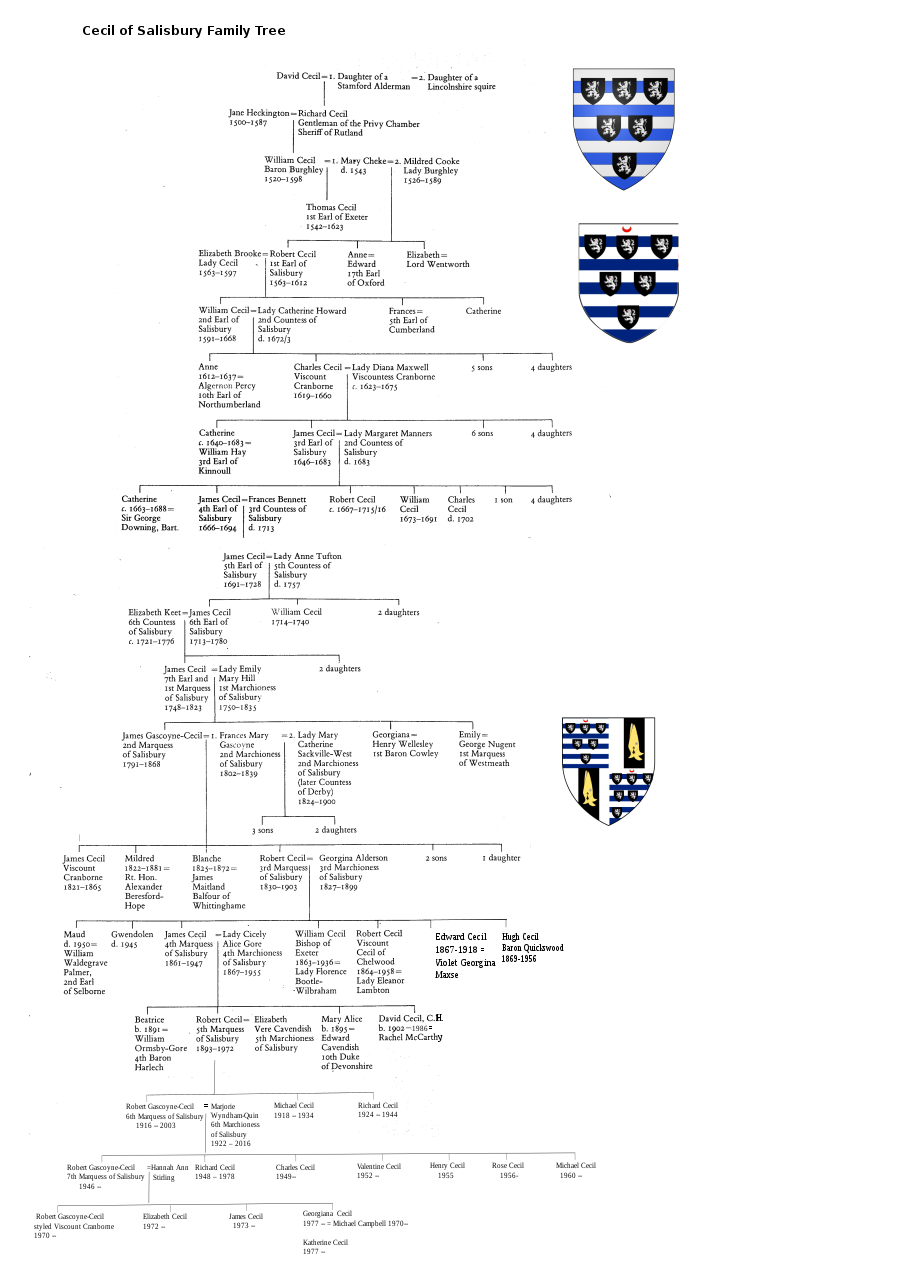Marquess of Salisbury
| Marquessate of Salisbury | |
|---|---|
heirs male of the body lawfully begotten | |
| Subsidiary titles | Earl of Salisbury Viscount Cranborne Baron Cecil |
| Status | Extant |
| Seat(s) | Hatfield House Cranborne Manor |
| Motto | SERO SED SERIO (Late but seriously) |
Marquess of Salisbury is a title in the Peerage of Great Britain. It was created in 1789 for the 7th Earl of Salisbury.[1] Most of the holders of the title have been prominent in British political life over the last two centuries, particularly the 3rd Marquess, who served three times as Prime Minister in the late 19th and early 20th centuries.
Background
This branch of the Cecil family descends from
The Earl of Salisbury was succeeded by his son, the second Earl. He represented
History

The seventh Earl was a politician and served as
He was succeeded by his eldest son, the second marquess. He was a Conservative politician and held office as Lord Privy Seal and Lord President of the Council. Lord Salisbury married as his first wife Frances Mary Gascoyne, daughter of Bamber Gascoyne, in 1821. The same year he assumed by royal licence the additional surname of Gascoyne.
He was succeeded by his third but eldest surviving son, the third marquess. The third marquess was Prime Minister three times, from 1885 to 1886, 1886 to 1892 and 1895 to 1902 and also served four times as
He was succeeded by his eldest son, the fourth marquess. The fourth marquess was also an influential Conservative politician and served as Lord Privy Seal, as President of the Board of Trade, as Lord President of the Council, as Chancellor of the Duchy of Lancaster and as Leader of the House of Lords. Like his father he was regarded as a staunch Conservative and bitterly opposed the Parliament Act 1911, which sought to curtail the powers of the House of Lords.
His eldest son, the fifth marquess, was also a Conservative politician. In 1941 he was summoned to the House of Lords through a
The fifth Marquess was succeeded by his eldest son, the sixth marquess. Although he briefly represented Bournemouth West in Parliament he did not take such an active role in national politics as his predecessors.
As of 2012, the titles are held by the sixth marquess's eldest son, the seventh Marquess, who succeeded in 2003. The seventh marquess is also a Conservative politician. After representing
Several other members of the Cecil family have gained distinction.

The family seats are Hatfield House and Cranborne Manor. The traditional burial place of the marquesses is the Salisbury Chapel in St Etheldreda Church, Hatfield, Hertfordshire. The 6th Marquess had holdings of 8,500 acres around Hatfield House, and 1,300 acres at Cranborne Manor, Dorset. At the time of his obituary he owned property around Leicester and Leicester Square, London, held by Gascoyne Holdings.[7]
All the marquesses, except the 6th marquess, have been appointed as Knights Companion of the Order of the Garter.
Earls of Salisbury (1605)
- Robert Cecil, 1st Earl of Salisbury (1563–1612)
- William Cecil, 2nd Earl of Salisbury (1591–1668)
- James Cecil, 3rd Earl of Salisbury (1648–1683)
- James Cecil, 4th Earl of Salisbury (1666–1694)
- James Cecil, 5th Earl of Salisbury (1691–1728)
- James Cecil, 6th Earl of Salisbury (1713–1780)
- James Cecil, 7th Earl of Salisbury (1748–1823) (created Marquess of Salisbury in 1789)
Marquesses of Salisbury (1789)
- James Cecil, 1st Marquess of Salisbury (1748–1823)
- James Brownlow William Gascoyne-Cecil, 2nd Marquess of Salisbury (1791–1868)
- Robert Arthur Talbot Gascoyne-Cecil, 3rd Marquess of Salisbury (1830–1903)
- James Edward Hubert Gascoyne-Cecil, 4th Marquess of Salisbury (1861–1947)
- Robert Arthur James Gascoyne-Cecil, 5th Marquess of Salisbury (1893–1972)
- Robert Edward Peter Cecil Gascoyne-Cecil, 6th Marquess of Salisbury (1916–2003)
- Robert Michael James Gascoyne-Cecil, 7th Marquess of Salisbury (b. 1946)
The heir apparent is the present holder's son Robert Edward William Gascoyne-Cecil, Viscount Cranborne (b. 1970).
Family tree
The Cecils are descended from
| |||||||||||||||||||||||||||||||||||||||||||||||||||||||||||||||||||||||||||||||||||||||||||||||||||||||||||||||||||||||||||||||||||||||||||||||||||||||||||||||||||||||||||||||||||||||||||||||||||||||||||||||||||||||||||||||||||||||||||||||||||||||||||||||||||||||||||||||||||||||||||||||||||||||||||||||||||||||||||||||||||||||||||||||||||||||||||||||||||||||||||||||||||||||||||||||||||||||||||||||||||||||||||||||||||||||||||||||||||||||||||||||||||||||||||||||||||||||||||||||||||||||||||||||||||||||||||||||||||||||||||||||||||||||||||||||||||||||||||||||||||||||||||||||||||||||||||||||||||||||||||||||||||||||||||||||||||||||||||||||||||||||||||||||||||||||||||||||||||||||||||||||||||||||||||||||||||||||||||||||||||||||||||||||||||||||||||||||||||||||||||||||||||||||||||||||||||||||||||||||||||||||||||||||||||||||||||||||||||||||||||||||||||||||||||||||||||||||||||||||||||||||||||||||||||||||||||||||||||||||||||||||||||||||||||||||||||||||||||||||||||||||||||||||||||||||||||||||||||||||

See also
- Marquess of Exeter
- Viscount Cecil of Chelwood
- Baron Quickswood
- Baron Rockley
- Viscount Wimbledon
Notes
- ^ "No. 13123". The London Gazette. 18 August 1789. p. 550.
- ^ "Prime Ministers in the House of Lords - History of government". history.blog.gov.uk. Retrieved 11 January 2022.
- ^ The 14th Earl of Home was the last prime minister to be a peer, but he disclaimed his peerage immediately after his appointment because he felt that it was impractical to serve as prime minister from the House of Lords
- ^ Andrew Roberts, Salisbury: Victorian Titan (2000), p. 374-75
- ^ "No. 52911". The London Gazette. 5 May 1992. p. 7756.
- ^ "No. 55676". The London Gazette. 23 November 1999. p. 12466.
- TheGuardian.com. 15 July 2003.
- ISBN 978-0-9711-9662-9.
References
- Kidd, Charles; Williamson, David (1990). Marquess of Salisbury. London and New York: St Martin's Press.
{{cite book}}:|work=ignored (help) - Burke's Peerage and Baronetage, ed. Charles Mosley, 107th edn., (London 2003), vol.III.
- http://www.cracroftspeerage.co.uk/salisbury1789.htm
- leighrayment.com[usurped]
Further reading
- Cecil, David. The Cecils of Hatfield House: An English Ruling Family. Houghton Mifflin, 1973.

